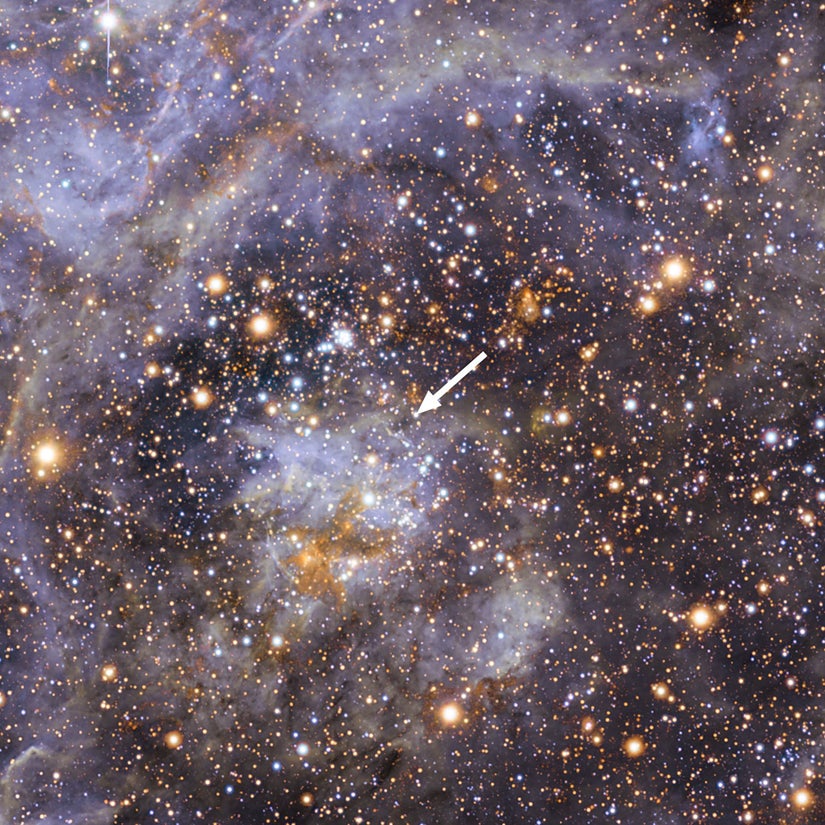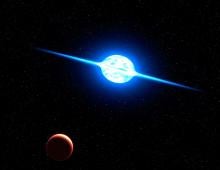
UCSB Scientist Contributes to Discovery of the Fastest-Rotating Massive Star Ever Recorded


An international team of scientists has found the fastest-rotating massive star ever recorded. The star spins around its axis at the speed of 600 kilometers per second at the equator, a rotational velocity so high that the star is nearly tearing apart due to centrifugal forces. This confirms a prediction put forward by astrophysicist Matteo Cantiello, a postdoctoral fellow with UC Santa Barbara's Kavli Institute for Theoretical Physics, who contributed to the discovery published this week in the Astrophysical Journal Letters.
The observations were made at the European Southern Observatory's Very Large Telescope, at the Paranal Observatory in Chile, as part of a survey of the heaviest and brightest stars in a region called the Tarantula Nebula. The Tarantula Nebula is a region of star formation located in a neighboring galaxy called the Large Magellanic Cloud, about 160,000 light years from Earth.
The reported star, VFTS 102, is extremely hot and luminous, shining about 100,000 times more brightly than the sun. According to the research team, this star had a violent past and was ejected from a double star system by its exploding companion star.
Cantiello and collaborators explained that stars could reach such rapid rotation via a "cosmic dance" with another star so close that gravity strips gas from its surface. "This gas falls onto the companion star, increasing the mass and spinning it up," said Cantiello. "Similar to a tennis ball spinning fast after being hit by a glancing blow, a star rotates quickly after being hit off-center by the in-falling gas."
Cantiello previously predicted the possibility of observing this type of star. He reported this theoretical finding with Sung-Chul Yoon, Norbert Langer, and Mario Livio in a paper published in 2007 in Astronomy & Astrophysics Letters. This theoretical investigation of stars in binary systems predicted extreme rotational velocities after mass accretion. The observed rotational velocity for the star agrees with this prediction.
The star is unusual not only because it rotates so fast, but also because it is moving away from its neighboring stars at a velocity of about 70,000 miles per hour, or 30 kilometers per second. "Having been part of a binary system could explain this space oddity," said Cantiello. "It has been known for over 40 years that a star in a massive binary system can be shot away from its surroundings when the companion ends its life in a spectacular explosion called a supernova. In our theoretical calculations we noticed that the ‘spun-up' star would also be moving from its surroundings at a high rate. It is very exciting to find a star that matches both of these predictions."
The star is located close to a pulsar and a supernova remnant, which may be left over from the companion star that once spun-up the observed star. If confirmed, this would provide additional support for the theoretical explanation put forward by Cantiello and collaborators in 2007.
Cantiello said that this star may produce dramatic fireworks as it dies. Such a rapidly rotating, massive star is believed to be the progenitor of some of the brightest explosions in the universe: gamma-ray bursts. These occur when the star's fast rotation produces powerful jets of light and matter.
† Top image: VFTS 102, the fastest-rotating massive star. This view shows part of the stellar nursery called the Tarantula Nebula in the Large Magellanic Cloud, a small neighbor of the Milky Way. The brilliant star VFTS 102 is in the center. This view includes both visible-light and infrared images from the Wide Field Imager at the MPG/ESO 2.2-meter telescope at La Silla, Chile and the 4.1-meter infrared VISTA telescope at Paranal, Chile. VFTS 102 is the most rapidly rotating massive star ever found.
Credit: ESO/M.-R. Cioni/VISTA Magellanic Cloud survey. Acknowledgment: Cambridge Astronomical Survey Unit
†† Middle image: This is an artist's concept of the fastest-rotating massive star found to date. The massive, bright young star, called VFTS 102, rotates at about two million kilometers per hour. Centrifugal force from this dizzying spin rate has flattened the star into an oblate shape, and spun off a disk of hot plasma, seen edge on in this view from a hypothetical planet. The star may have "spun up" by accreting material from a binary companion star.
Scientists believe that the rapidly evolving companion star later exploded as a supernova. The whirling star lies 160,000 light years away in the Large Magellanic Cloud, a satellite galaxy of the Milky Way.
Credit: NASA/ESA and G. Bacon (STScI)
Related Links
VLT-FLAMES Tarantula Survey
ESO press release
Kavli Institute for Theoretical Physics
Matteo Cantiello



